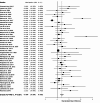Effects of different supervised and structured physical exercise on the physical fitness trainability of children and adolescents: a meta-analysis and meta-regression : Physical fitness trainability in children and adolescents' health
- PMID: 39639233
- PMCID: PMC11619429
- DOI: 10.1186/s12887-024-04929-2
Effects of different supervised and structured physical exercise on the physical fitness trainability of children and adolescents: a meta-analysis and meta-regression : Physical fitness trainability in children and adolescents' health
Abstract
Background: Physical fitness has been considered an important health indicator. Several factors can impact the increase in physical fitness in children and adolescents, including chronological age, sex and BMI, in addition to training variables such as weekly frequency, session and intervention duration, and types of exercises performed. To know the importance of variables that can impact physical fitness, it is important for health professionals to identify the most efficient way of prescribing physical exercises for children and adolescents. The aim is review and meta-analyses of the effects of supervised and structured physical exercise on the physical fitness trainability of children and adolescents.
Methods: Relevant articles were searched in the PubMed, Cochrane Library, Embase and Scopus platform databases and selected based on the following criteria: children and adolescents aged between 7 and 17 years who performed any type of structured physical exercise compared to a control group without exercise and evaluating physical fitness (strength or muscular power, cardiorespiratory fitness (CRF) or speed. The results are reported in accordance with PRISMA 2020.
Results: Eighty studies were included with a total of 5769 participants. Strength exercises (ES: 1.073; 95% CI, 0.612-1.533; P < 0.001; I2: 74%), concurrent (ES: 1.054; 95% CI, 0.255-1.853; P < 0.010; I2: 72%) and sports (ES: 0.573; 95% CI, 0.015 to 1.132; P < 0.044; I2: 34%) seem to be the most effective in increasing muscular strength. Aerobic activities (ES: 0.400; 95% CI, 0.258-0.542; P < 0.001; I2: 74%), sports (ES: 0.271; 95% IC, 0.148-0.394; P < 0.001; I2: 15), or HIIT (ES: 0.668; 95% IC, 0.333-1.003; P < 0.001; I2: 29%) resulted in increased CRF (ES: 0.514; 95% IC, 0.220-1.808; P < 0.001; I2: 66%). The practice of physical exercise increased muscular power (ES: 0.241; 95% CI, 0.053-0.429; P = 0.012; I2: 0%). The practice of HIIT impacts MAS gains (ES: 0.048; 95% CI, 0.050 - 0.026; P = 0.029; I2: 44%).
Conclusion: Supervised and structured physical exercise can improve muscular strength (15-35%), CRF (5.4-8.5%), muscular power (5.6-11.8%), and MAS (5.4%) trainability in children and adolescents. Sex, BMI of the subjects and type of exercise performed (aerobic activities, exclusive to strength, HIIT or sports) should be considered when prescribing the exercise.
Keywords: Cardiorespiratory fitness; Maximal aerobic speed; Muscular power; Muscular strength; Training.
© 2024. The Author(s).
Conflict of interest statement
Declarations. Ethics approval and consent to participate: Not applicable. Consent for publication: Not applicable. Competing interests: The authors declare no competing interests.
Figures





References
-
- Andersen JR, Natvig GK, Aadland E, Moe VF, Kolotkin RL, Anderssen SA, et al. Associations between health-related quality of life, cardiorespiratory fitness, muscle strength, physical activity and waist circumference in 10-year-old children: the ASK study. Qual Life Res. 2017;26:3421–8. 10.1007/s11136-017-1634-1 - PubMed
-
- Cadenas-Sanchez C, Migueles JH, Esteban-Cornejo I, Mora-Gonzalez J, Henriksson P, Rodriguez-Ayllon M, et al. Fitness, physical activity and academic achievement in overweight/obese children. J Sports Sci. 2020;38:731–40. 10.1080/02640414.2020.1729516 - PubMed
-
- de Lima TR, Martins PC, Moreno YMF, Chaput JP, Tremblay MS, Sui X, et al. Muscular fitness and cardiometabolic variables in children and adolescents: a systematic review. Sports Med. 2022;52:1555–75. 10.1007/s40279-021-01631-6 - PubMed
Publication types
MeSH terms
LinkOut - more resources
Full Text Sources
Medical

